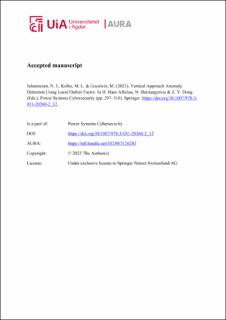| dc.contributor.author | Johannesen, Nils Jakob | |
| dc.contributor.author | Kolhe, Mohan Lal | |
| dc.contributor.author | Goodwin, Morten | |
| dc.date.accessioned | 2024-04-12T09:13:52Z | |
| dc.date.available | 2024-04-12T09:13:52Z | |
| dc.date.created | 2023-03-19T18:14:36Z | |
| dc.date.issued | 2023 | |
| dc.identifier.citation | Johannesen, N. J., Kolhe, M. L. & Goodwin, M. (2023). Vertical Approach Anomaly Detection Using Local Outlier Factor. In H. Haes Alhelou, N. Hatziargyriou & Z. Y. Dong (Eds.), Power Systems Cybersecurity (pp. 297–310). Springer. | en_US |
| dc.identifier.isbn | 978-3-031-20360-2 | |
| dc.identifier.uri | https://hdl.handle.net/11250/3126243 | |
| dc.description | Author's accepted manuscript | en_US |
| dc.description.abstract | Detection of anomalies based on smart meter data is crucial to identify potential risks and unusual events at an early stage. In addition anomaly detection can be used as a tool to detect unwanted outliers, caused by operational failures and technical faults, for the pre-processing of data for machine learning, to detect concept drift as well as enhancing cyber-security in smart electrical grid operations. It is known that anomalies are defined through their contextual appearance. Hence, anomalies are divided into point, conceptual and contextual anomalies. In this work the contextual anomaly detection is examined, through a novel type of load forecasting known as vertical approach. This chapter explores the use of anomaly detection in the relevant learning systems for machine learning in smart electrical grid operation and management through data from New South Wales region in Australia. The presented vertical time approach uses seasonal data for training and inference, as opposed to continuous time approach that utilizes all data in a continuum from the start of the dataset until the time used for inference. It is observed that Local Outlier Factor identifies different local outliers given different vertical approaches. In addition, the local outlier factor score vary vertically. An anomaly is defined as a deviation from an established normal pattern. Spotting an anomaly depends on the ability to defy what is normal. Anomaly detection systems aim at finding these anomalies. Anomaly detection systems are in high demand, despite the fact that there is no clear validation approach. These systems rely on deep domain expertise. | en_US |
| dc.language.iso | eng | en_US |
| dc.publisher | Springer | en_US |
| dc.relation.uri | https://link.springer.com/chapter/10.1007/978-3-031-20360-2_12 | |
| dc.title | Vertical Approach Anomaly Detection Using Local Outlier Factor | en_US |
| dc.type | Chapter | en_US |
| dc.type | Peer reviewed | en_US |
| dc.description.version | acceptedVersion | en_US |
| dc.rights.holder | © 2023 The Author(s) | en_US |
| dc.rights.holder | Under exclusive license to Springer Nature Switzerland AG | |
| dc.subject.nsi | VDP::Teknologi: 500::Informasjons- og kommunikasjonsteknologi: 550 | en_US |
| dc.source.pagenumber | 297-310 | en_US |
| dc.identifier.doi | https://doi.org/10.1007/978-3-031-20360-2_12 | |
| dc.identifier.cristin | 2135093 | |
| cristin.qualitycode | 1 | |
